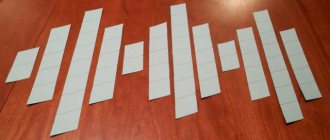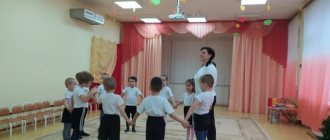Drawing on the theme “Beautiful Bird” in the middle group of kindergarten
Birds are representatives of wildlife that are familiar to children from an early age through fairy tales and personal observations. These animals differ in plumage, size, and habits, so every boy or girl will be able to find their favorite breed among them, which they want to portray.
One of the simplest and most interesting drawings"
The purpose of drawing on the theme “Beautiful Bird” in a preschool educational institution
The main goal of this event is to develop children's creative abilities and gain skills in individual and group work.
Example of lesson notes
- Introducing children to the topic of the lesson;
- Distribution of additional materials;
- Reviewing with students diagrams, templates, illustrations of what they need to draw;
- Step by step drawing;
- Discussion of the work done and summing up the results.
Summary of the drawing lesson “Decorate your toys (decorative drawing)”
Lesson notes
“ Decorate your toys
(decorative drawing)”
for children of the general development group, aged 4 to 5 years
Date of:
Educational area:
Artistic and aesthetic development
Class:
Drawing
Priority:
Artistic and aesthetic development is integrated with physical development, social and communicative development, speech development, cognitive development.
Target:
introduce children to the features of Dymkovo painting.
Tasks:
Educational:
— Continue to introduce children to Dymkovo toys, teach them to note their characteristic features, and highlight the elements of the pattern: circles, rings, dots, stripes.
— To strengthen children’s understanding of the bright, elegant, festive colors of toys.
— Reinforce brush painting techniques.
Educational:
— Develop aesthetic perception.
Educational:
— Cultivate accuracy in working with gouache.
Preliminary work:
Acquaintance with Dymkovo products and their painting. Modeling toys.
Forms of work
: Individual, joint activities of the teacher with children, independent activities of children.
Methods:
Verbal:
questions for children, conversation about toys.
Visual
: Dymkovo young ladies, duck, horses, pictures of Dymkovo toys, a sample of a decorated toy
.
Practical:
productive activity.
Types of children's activities
: gaming, communicative, motor, productive.
Individual work
: One toy is drawn on the sheet, draw and paint the second one by analogy.
Materials and equipment:
Demo material
: Dymkovo young ladies, duck, horses, pictures of Dymkovo toys, a sample of a decorated toy
.
Handout:
Landscape sheets, gouache paints, brushes, a jar of water, a napkin (for each child).
Motivation:
invitation to the Dymkovo Toy Museum.
Progress of the lesson:
I. _ Introductory part
Motivational moment:
Educator:
Guys, today I have prepared a surprise for you.
Have you ever been to a museum? ( children's answers
) I invite you to the museum.
Would you like to visit the museum with me? ( children's answers
) Close your eyes (
music sounds
).
Open your eyes. Here we are in the museum ( they go to the table with toys
)
II.
Main part Educator:
Today there is a toy exhibition at the museum.
Look at them, how bright and elegant they are. Can someone tell me what these toys are called? ( children's answers - Dymkovo
) That's right, this is a Dymkovo toy!
Let's, guys, remember the history of this toy. Why were they called that? ( children's answers - because they were made in the village of Dymkovo
) Educator: Why was this village called Dymkovo?
( children's answers
) That's right, because in winter, when the stoves are heated, and in summer, when there is fog, the village seems to be in a haze (
looking at pictures of a village in winter)
Educator:
There is a column of smoke from the chimneys, as if everything is in a haze.
They gave a blue light, and the large village was named “Dymkovo”. People loved songs and dances there, and wonderful fairy tales were born in the village. All toys are not simple, but magically painted. They themselves are snow-white, like birch trees, and they have bright circles, squares, and stripes on them. Educator: Yes, in the old days, in the village of Dymkovo, the Dymkovo toy was born.
What did the craftsmen make it from? ( children's answers - We made this toy from clay)
.
But clay toys don’t look very elegant, so how did Dymkovo ones turn out so cheerful and elegant? ( children's answers - because the Dymkovo masters painted them with bright patterns
) Educator: What elements of painting did the masters use? (children's answers - circles, stripes, dots, grid, ring) Educator: Well done, right. Do you know that there is a secret in these elements: the circle means the sun, the wavy lines mean water, and the intersection of straight lines means the earth. Educator: What colors did the masters use to paint the toy?
(red, yellow, green, blue, orange) Educator: Look, guys, there’s a little duck swimming in the lake. And here are her ducklings. What happened to them, why are they all white and not as bright and beautiful as their mother? What are we going to do? ( children's answers)
I invite you to be a little master of the Dymkovo toy.
Educator: Let's go to our workshop.
Physical education minute . The ducks came out into the meadow, quack-quack-quack! (We walk.) A cheerful beetle flew by, J-z-z! (We wave our arms like wings.) The geese arch their necks, Ha-ha-ha! (Circular rotation of the neck.) The feathers are straightened with the beak. (Turns the body left and right.) The reeds whispered in the water, Shhhh! (They raised their hands up and stretched.) And again there was silence, Sh-sh-sh.
Educator: Look, guys, in our workshop we have everything to turn an ordinary figurine into a real painted Dymkovo toy.
You and I will paint our ducks with Dymkovo patterns. Let's look at the patterns on our duck ( look at the patterns on the duck)
Educator: A duck is a favorite image in folk art associated with the sun and abundance.
The chest and wings of the bird are decorated with patterns reminiscent of a large and small sun. Duck-Marfutka is walking along the shore, Duck-Marfutka is leading him to swim. Educator. Look how I decorated my duck. Guys, remember how to work when painting. Before picking up another paint, you need to rinse the brush, and only then take another paint. Now we draw dots with the tip of the brush. We draw the stripes by placing the brush on the paper and moving it from left to right. And now I propose to take your jobs. See what's ready for work. We remember how we use a napkin, how we remove excess paint, and rinse the brush. ( Work done by children
) Educator: Guys, you are real folk craftsmen, you did a good job.
Children look at the painted ducklings and express their opinions.
Children close their eyes, music sounds.
III. Final part
Educator:
Here we are again in kindergarten.
- Guys, where have we been?
– Whom did we describe?
— Did everything work out for you or did you have difficulties?
Questions for children based on their drawings
You should not finish the lesson immediately after drawing. Children should be encouraged to talk about what and why they drew. You can give the guys a little time to create a full-fledged history of their bird, give it a name, come up with a breed if one does not exist.
You can also ask the children whose bird is the most beautiful and why. But with this task you need to be very careful, because you cannot single out anyone, and you should not deprive them of attention. Some can be praised for their drawing technique and accuracy, some for their unusual story, and some for their successful combination of colors and realism.
This lesson will introduce children not only to a whole section of wildlife, but will also help develop their creative and social skills. For these reasons, art lessons should be taught as early as possible so that children from an early age are introduced to the broad concept of “beauty” and learn to work in a team.
Preliminary work with children, discussion of the topic
Before moving on to the main part of the task, you should make sure that the children have a complete understanding of birds. To do this, you need to show them these animals live. If it is spring or summer at the time of the lesson, then you can go outside, because birds are especially active during this period. If it’s winter, when many birds go south, you have to be content with pictures or stuffed animals. You should also tell children about different types of birds, among which are:
- Migratory;
- wintering;
- domestic.
It is also necessary to talk about the diet of birds: mosquitoes and other insects, seeds and fruits. To captivate children even more, you can tell children fairy tales about these animals, ask them to guess riddles about birds, and also talk about interesting expressions like “small bird.”
Physical education minute
To prevent children from getting bored, physical education sessions must be held once an hour. If the room is large and spacious enough, then you can perform several dance moves to funny short songs.
Note! You can find songs about birds and invite children to perform flapping movements to the music, similar to flapping their wings. If the class is not very large, then you can do eye exercises.
Physical education for birds"





